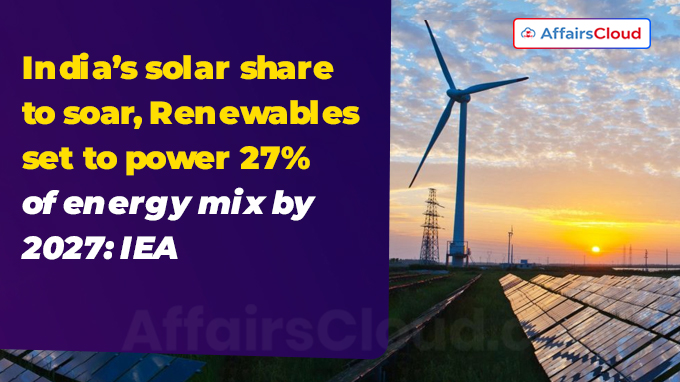 India’s share of renewable energy(RE) is projected to rise from 21% in 2024 to 27% by 2027. According to the International Energy Agency (IEA), the growth is mainly driven by solar power, which is expected to increase by more than 28% between 2025 and 2027.
India’s share of renewable energy(RE) is projected to rise from 21% in 2024 to 27% by 2027. According to the International Energy Agency (IEA), the growth is mainly driven by solar power, which is expected to increase by more than 28% between 2025 and 2027.
- This transition aims to balance economic growth, energy security, and environmental sustainability over the next decade.
Highlights:
i.Wind, Hydropower, and Nuclear Growth (2024-2027):
- Wind energy: From 2018 to 2024, wind energy grew at a 7% compound annual growth rate (CAGR), with a forecasted increase to 11% CAGR from 2025 to 2027. The government has approved Rs.74.5 billion for India’s first offshore wind projects, installing 1 GW capacity off Gujarat and Tamil Nadu (TN).
- Hydropower: Expected to grow at a 7% CAGR between 2025 and 2027, with a 21.1 GW small hydropower potential identified by the Central Electricity Authority (CEA). The government has allocated Rs.41.4 billion for small hydropower projects and Rs.124.6 billion for infrastructure.
- Nuclear power: In 2024, nuclear energy capacity rose by 13%, and the government plans to triple its capacity from 8.2 GW to 22.5 GW by 2032. Development includes Pressurized Heavy Water Reactors (PHWRs) and Bharat Small Modular Reactors (BSMRs) for localized power generation.
ii.Coal and Thermal Power Outlook (2024-2032): Despite the rise of renewables, coal continues to dominate India’s energy mix, accounting for 74% of the power in 2024, with a projected decline to 67% by 2027.
- The growth of coal-based power slowed from 4% CAGR (2018-2024) to a forecasted 2% CAGR (2025-2027).
- Gas-fired power is expected to grow at 9% annually from 2024 to 2027.
- India’s thermal power capacity is expected to rise from 218 GW to 283 GW by 2032, with 80 GW of new coal capacity planned, alongside 500 GW of non-fossil fuel capacity by 2030.
iii.Rising Electricity Demand (2024-2030): According to the International Monetary Fund (IMF), electricity demand in 2024, surged by 5.8% year-on-year (YOY), driven by 7% economic growth and extreme heatwaves.
- The peak demand reached a record 250 GW in May 2024, surpassing 243 GW in September 2023.
- By 2030, peak demand is expected to exceed 400 GW, with 65% of this capacity coming from non-fossil fuel sources.
Initiatives launched :
i.PMSGMBY Scheme (2024): In February 2024, the Government of India(GoI) launched the PM-Surya Ghar: Muft Bijli Yojana (PMSGMBY) to accelerate the shift to RE.
- This initiative aims to provide rooftop solar systems generating 300 kiloWatt (kW) hour per month to 10 million households, adding 30 GigaWatt (GW) of capacity.
- The scheme has a financial outlay of Rs.700 billion, offering up to 60% capital subsidies and incentives for distribution companies (DISCOMs).
ii.Solar Plant Installations (2024): In 2024, the Indian government amended the Electricity (Rights of Consumers) Rules, making it easier to obtain electricity connections and install solar plants.
- Systems up to 10 kW now do not require feasibility studies and will receive automatic approval if DISCOMs do not process applications within 15 days.
iii.National Electricity Plan for Renewable Capacity (2024-2032): The National Electricity Plan (Transmission) introduced in October 2024 aims to facilitate the transmission of 500 GW of renewable capacity by 2030, increasing to 600 GW by 2032.
- This includes 47 GW of battery storage, 31 GW of pumped hydro storage, and infrastructure for green hydrogen and ammonia transportation to coastal manufacturing hubs.
About International Energy Agency (IEA):
Executive Director (ED)– Fatih Birol
Headquarters– Paris, France
Established– 1974




